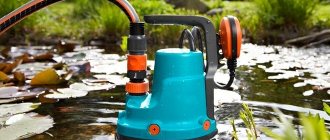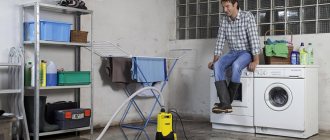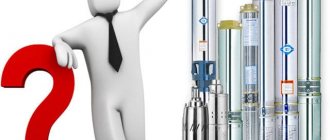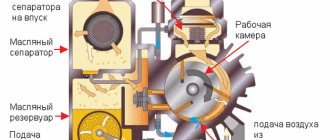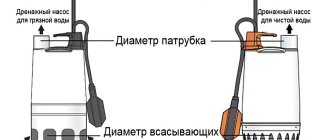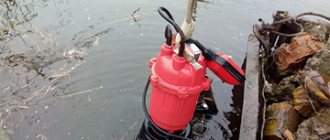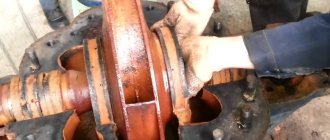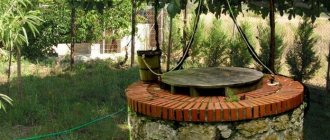Here you will learn:
- When do you need a pump to pump out water?
- Pumping water from a source: the essence of the process
- Which pump is suitable for pumping water
- Types of household pumps
- How to choose
- Comparative review of the best manufacturers
- How to make a hand pump for pumping out water with your own hands
A pump for pumping out water is necessary in many cases - when you need to pump out water from a swimming pool, from a flooded garage, to water plants from a barrel, and in many others. Such pumps are manual and mechanized, submersible and surface. We understand the types and the correct choice of equipment.
Types of pumps
Pumps for drinking water and dirty water
Pumps for industrial water
Divided into two types:
- fecal type;
- drainage type.
However, drainage pumps are capable of pumping liquids with large solid elements. Therefore, in order not to damage the unit, a filter with a fine mesh is attached to the pipe. This will prevent large waste from getting inside the unit. This type of pump is universal and can be used not only for basements and cellars. It is used when cleaning dirty swimming pools, artificially created reservoirs, and wells.
This is not the case with a fecal pump. It is not intended for pumping liquids containing solids. Some models of such devices may have a cutting mechanism for shredding large debris.
Submersible pump “Baby”
A representative of this type of pumping equipment is the “Malysh” submersible pump.
The pump is immersed in water, and it should not lie on the bottom, since it takes in liquid with the lower part, and at the bottom there are silty deposits that can clog it. The device does not require special cooling of the electric motor elements because the waste materials themselves have a low temperature. The device may be equipped with a circuit breaker. So, when the liquid reaches a specific point, using a float, the device is disconnected from the network. If the maximum level of wastewater is exceeded, the unit starts working again.
The Baby's body is equipped with reliable waterproofing. If the seal of the housing is broken, water can enter the engine and damage it. Therefore, you need to periodically remove the device from the water and check the integrity of the housing.
Submersible and external pumps
Principle of operation
These types, depending on the methods of work, are divided into submersible and external. The operation of a submersible pump involves its complete immersion in water.
These pumps must meet the following requirements:
- resistance to chemicals;
- to corrosive formations;
External pumps are only partially lowered into the liquid; the main part of the device is on the surface of the water. Basically, these devices are mobile, but less powerful than the submersible type, which helps save energy.
Features of external pumps
These devices are designed for periodic pumping of water.
Their prolonged use puts a lot of stress on the mechanism, which leads to breakdown. Liquid intake occurs through flexible hoses. In this way, it is possible to pump out liquids up to eleven meters deep. Moreover, the presence of large particles up to ten millimeters in water is acceptable.
Centrifugal type unit design
The unit has a pump chamber and a motor compartment. The rotor (shaft) connects the working compartment and the engine. The shaft contains wheels with blades designed to pump liquid and maintain high line pressure. This pump is easy to install. The body is mainly made of polymer or stainless steel.
Manufacturers of these pumps are such global brands as Gardena, Pedrollo, Karcher, Dab. There are also domestic manufacturers - Gileks and Sprut. The most popular brand of devices for pumping out dirty water is Pedrollo Pkm60. This model is capable of maintaining pressure up to forty meters, as well as pumping up to two thousand liters of water in 1 hour. Equipped with a cast iron body.
We should also highlight the OPTIMA JET 80S-PL pump, which has established itself as the best among the owners of country houses. The case is made of steel and has a power of up to eight hundred watts. Maintains pressure at a distance of up to thirty-three meters. Capable of pumping water up to 3 cubic meters. m/hour.
Centrifugal units
The housing of centrifugal pumps can be monolithic or cantilever.
The top of the device performs a protective function, and the work area is located at the bottom. The chamber contains impellers with an impeller in a circle. There is a filter with a mesh under the wheels. There is a stand on the bottom of the device. They have a throughput capacity of no more than two to two and a half centimeters. The following brands of submersible pumps are Aquatica, Grudfos, Gilex, Metabo, Sturm.
The most common is the Aosta AB SMP 400SS DO pump, which has a power of up to four hundred watts. The unit has an auxiliary discharge connection. Automated operation occurs through a float switch. Can work at a depth of up to five meters. Withstands water pressure at a distance of up to ten meters. Capable of pumping liquids up to 298 l/min.
You can also highlight the domestic pump Drainage 200/25, produced by the company Gilex.
Vibration units
The liquid is pumped through the oscillating movements of the resonator. Centrifugal devices are represented by dynamic devices, and vibrating devices are volumetric devices.
The working chamber of such devices has a membrane that serves as a closure to the engine compartment. It is fixed on a metal rod. The engine here is replaced by a capacitor, which attracts liquid during the working process.
At the same time, the working chamber expands, and water is drawn in through a vacuum. When the chamber narrows, the liquid is pushed into the pipe and the inlet is closed using an inverse valve. This ensures water supply without jerking. In terms of productivity, this type is inferior to the centrifugal one.
Water pumps of both submersible and surface types are quite expensive. So, for periodic use, it is not always advisable to purchase an expensive electric pump. The best option here would be to purchase a hand pump. This device is made like a pneumatic hand pump. Here the piston represents the working element.
When the handle is lifted upward, the rod and cylinder are tightened. In this case, the chamber is filled with rarefied air and water begins to be absorbed. When the handle is turned down, the pressure increases and the liquid closes the valve in the suction hole and all water under pressure is discharged through the pipe.
Naturally, in terms of functional characteristics, a manual type device cannot compete with electric devices, but in terms of ease of operation it can compete with electric models.
Design and principle of operation of the drainage system
Pumps for pumping are divided according to the principle of operation:
- Vibrating.
- Vortex.
- Centrifugal.
Vibrating
The principle of its operation is based on the occurrence of an electromagnetic field. It is created by installed coils. Once the existing rubber diaphragm flexes, low pressure is created, which causes water to be sucked in. However, due to voltage surges in the electrical network, malfunctions may occur.
Vortex
The work process is carried out under the influence of a vortex wheel. It is a metal disk with blades. When suctioned, the water twists into a spiral that resembles a vortex. This type of device provides high performance.
Centrifugal
A centrifugal force is generated inside the body, under the influence of which the water is set in motion. When the blades rotate, it is sucked in and pressed against the walls, and then pushed out. The centrifugal unit is capable of working with high temperature liquid.
Recommendations for use
In order for the pump for pumping out dirty water to work without interruptions and frequent breakdowns, it is necessary to follow certain rules for its use. This also includes the conditions that must be created when operating the drainage pump.
- The ambient temperature in which the self-priming pump for dirty water operates should not exceed 40°.
- The density of the liquid for pumping out which self-priming drainage pumps are used should not exceed 1000–1200 kg/m3.
- The amount of solid inclusions in the liquid medium that the drainage pump will pump out should not exceed 10%.
- Industrial hydraulic machines for contaminated water are connected to a three-phase electrical network with a voltage of 380 V, household models - to a single-phase one (with a voltage of 220 V and a frequency of 50 Hz).
Which drainage pump is better to buy?
If equipment is needed primarily for pumping out liquid in wells and boreholes, to change the groundwater level, then it is better to choose submersible models. For those who plan to use it to water the garden to a greater extent, then the optimal choice would be a surface-type device. To work with contaminated liquids, it is important that the product has special cutting elements, and the permissible size of impurities is no more than 35 mm.
Here's what model you can choose based on different situations:
- To reduce the volume of liquid in wells, Zubr NPG-M1-550 or Caliber NBTs-380 would be relevant.
- To clean swimming pools, you can use Gnome 40-25T with r/o.
- On construction sites, if it is necessary to remove excess water in pits, Quattro Elementi Drenaggio 1100 F Inox or Belamos DWP 2200 are suitable.
- Gilex Drainage 220/12 will do an excellent job of putting things in order in basements.
- Watering the garden will be well provided by Patriot QB60, Stavr NP-800 and Unipump JET 80.
- The Whirlwind PN-900 can be useful for draining small bodies of water.
When choosing a drainage pump, it is better not to save money, since very cheap equipment may not be powerful enough to work properly with water. The main parameter for their evaluation, as it turned out during the selection process, is the power of the devices.
How to choose the right model
Among the models of drainage pumps for dirty water, how to choose the best option? When purchasing a pump for pumping water from a basement or cellar, you should first decide on the list of tasks for which such equipment will be used. We list the parameters by which drainage, as well as well or borehole electric pumps are selected.
Characteristics of the pumped liquid
This refers to its type, degree of contamination, as well as the maximum particle size of solid inclusions contained in its composition. In particular, the diameters of the inlet and pressure pipes of the selected pump, as well as the volume of its internal working chamber, depend on this characteristic.
The stainless steel mesh filter is reliable and durable
Performance
This parameter characterizes the volume of liquid that the pump is capable of pumping per unit of time. You should focus on the degree of intensity with which you plan to use the pumping equipment, as well as the amount of dirty water that it will have to pump out.
Created pressure
This parameter determines the degree of contamination of the liquid that a pump of a certain model can pump out from a cellar or basement, and the distance over which the pumped liquid will be transported along a horizontal section of the pipeline or hose. The depth from which such equipment can pump out a liquid medium also depends on the pressure value created by the electric pump. If you are thinking about how to pump water from a well or borehole and ensure its transportation through an irrigation or water supply system, consider not only the depth of the underground source and the total length of the horizontal section of the pipeline, but also the height to which the water pumped must be raised above the surface of the earth.
Ease of use will also be an important criterion for choosing a pump. For example, easy adjustment of the pumping level by moving the sensor or quick connection of the pressure hose
Location of the inlet pipe
The inlet pipe can be located at the top or bottom of the pump housing, as well as on its side. In the event that the selected hydraulic machine is planned to be used for pumping liquid media from flooded cellars or basements, preference should be given to models with a lower nozzle location. If, with the help of a drainage pump, water will be pumped out of silted reservoirs, it is better to choose equipment with an upper location of this element.
Availability of additional options
If you are interested in purchasing a really good drainage pump, it is better to opt for models that are equipped with all the necessary automation elements. This includes, in particular, idle and overheat sensors, as well as float-type switches. In this case, you need to know the following fact: while floatless drainage pumps can be selected for pumping water from basements, trenches or cellars, it is not recommended to use them for pumping liquid media from wells, septic tanks or cesspools.
If you do not take into account the prestige of the manufacturer, the cost of drainage pumps is significantly influenced by their performance and the ability to pump liquids with large solid particles
Compact pumping stations for domestic use
For the uninterrupted and efficient functioning of autonomous water supply systems for dachas and private houses in automatic mode, compact pumping stations have recently been increasingly used. The use of such stations, which include several technical devices, makes it possible to minimize human participation in controlling the operation of pumping equipment due to automation elements. The compact dimensions of household pumping stations for pumping water, which, despite their small size, are characterized by high performance and are capable of creating good pressure in the pipeline system, allow such equipment to be installed in any convenient place, including in the basement of a residential building.
The household pumping station includes the following technical devices:
- submersible centrifugal pump that pumps water from an underground source;
- a filtration unit in which water from an underground source is purified from solid inclusions;
- a circulation pump designed to pump water from the filter unit to the station’s hydraulic accumulator;
- a hydraulic accumulator, the internal chamber of which, filled with water, is equipped with a special membrane (the task of this device is to maintain constant pressure of the liquid medium in the autonomous water supply system, as well as to provide this system with water in those moments when the station pump does not work due to a breakdown or lack of power).
Automatic pumping station for individual water supply systems and small garden plots
The operation of a household pumping station in automatic mode is ensured by a pressure switch, which automatically turns off the pumping equipment if the level of water pressure in the accumulator rises to a critical level, and also turns it on when such pressure drops below the permissible value.
Mini-pumps are actively used not only in everyday life, but also in industry, in particular in food industry enterprises. To pump liquid and viscous media used in technological processes at enterprises in this industry, special food pumps are needed, the structural elements of which are made of materials that are highly resistant to oxidation and do not release harmful substances into the pumped medium.
Overview of possible options
A pool in the basement, garden or home should ensure the safety of swimmers. Therefore, the presence of blooming water in the bowl that does not meet the requirements of sanitary and hygienic standards should under no circumstances be allowed. To prevent problems and timely cleaning of the walls of the bowl, water is periodically pumped out of the pool using various pumps.
1. Immersion format – a combination of simple design and impressive functionality
Using submersible pumping equipment for his pool, the developer will be able to pump water through a grate located in his body. Using the equipment is very simple - it is placed on the bottom of the pool and the motor is started, after which the water is pumped and supplied upward. The device is used not only for pools, but also for draining wells, cesspools, basements and cellars.
Among the advantages of the pump, it is worth highlighting its prevalence, light weight, compact dimensions and affordability. The disadvantages also cannot be ignored. They are represented by limited performance.
2. Surface pump – ease of use and high power
If for some reason the developer does not consider the possibility of using submersible equipment, he still has the option of using a surface pump. It has a completely different format. The equipment is placed above the surface of the water surface, and a special flank connected to the body is lowered into a bowl of water. When the equipment motor is started, water begins to be pumped out of the tank.
Types of fecal pumps by type of installation
Any sewage pump in a private house is placed relative to the working environment in various ways; on this basis, all models can be divided into the following categories.
Submersible
A submersible pump is placed at the bottom of the tank from which sewage is pumped out; such models have a base (legs) at the bottom for installation on the bottom and are equipped with a float switch - their engine without water cooling quickly fails. Submersible sewage pumps are the most common type in everyday life; when placed in a waste tank, they use two main installation methods: they place the device directly with its base on the bottom or attach it with a side pipe to a free-standing platform (Fig. 15).
Rice. 3 Internal structure of submersible units
Semi-submersible
Semi-submersible drainage pumps for pumping sewage water are a unit with separated electrical and hydraulic parts. The engine is equipped with a long shaft, at the end of which a disk wheel is fixed; the pumped liquid from the chamber of the hydraulic part is supplied upward through a rigid pipeline, structurally connected to the electric pump. When collecting fecal waste, the pump is immersed to the bottom, installed on a rigid base in the lower part; some models are designed for manual or mechanical holding with the ability to move along the bottom of the container. Semi-submersible pumps are convenient for quickly pumping out fecal waste from difficult places and are used for professional purposes; the units are not widely used in everyday life due to their high cost and specific use.
To pump sewage, the following methods are used to immerse the suction hydraulic part of the pump into the source:
- The unit is placed on a rigid platform resting on the walls of the object from which fecal waste is pumped out. For insurance, a float switch is attached to the edge of the container, which cuts off the power supply when the liquid rises - this prevents failure of the unprotected electric motor if water gets on it.
- Place the electric pump on a floating platform - this placement allows you to pump out liquid from great depths in a wide range without constantly reinstalling the unit.
- The transfer pump is hung on the wall of the tank with fecal waste; this method is used when working with small units.
Rice. 4 Semi-submersible varieties of feces - internal structure
Related article:
Sewerage in the country - options, design diagrams and installation. If you need to install a sewer system in your dacha, then in a separate article read about all the possible expensive and cheap options for arranging a sewer system in your dacha. Nuances, types, schemes.
Superficial
Surface-type sewer pumps operate on a centrifugal operating principle and are not much different from water pumps in appearance; they are installed on the surface next to the source of sewage waste; the intake is carried out by lowering a rigid hose or pipe into the tank. Surface electric pumps are subject to the rule for all external units - the depth of immersion of the suction pipe into the liquid cannot be higher than 9 m. It should be noted that surface models are not used in households, and they are not very often found in professional or industrial applications.
Review of models and manufacturers
The selection of equipment begins with an inspection of how much a particular model costs.
But it is important to pay attention to the manufacturer. Here are several options for water pumping/pumping equipment that are deservedly popular:
- A water jet is equipment designed for pumping flows from a well/borehole. The throughput of insoluble inclusions is low, price starts from $80
- Baby - a design ideal for summer cottages. Low performance affects the low price (from $40).
- A brook is a device for supplying water from wells and wells of medium depth. Unpretentiousness to the percentage of contamination, excellent performance, ease of installation and lightness of the device are complemented by low cost (from $30), but the service life is no more than 3-5 years.
- The Gilex model range is equipment intended for domestic use in both water supply and sewerage systems. Excellent practical qualities, work with different depths, unpretentiousness to contamination, a very long service life and good maintainability are clear advantages of the brand. Equipment cost from $200
- Belamos - models are used for supplying clean drinking water and irrigation. They have a built-in control unit, which makes the units easier to use, and can operate in manual, automatic and scheduled modes. There is also a filter to improve the quality of the supplied flow, overload protection, productivity up to 2800 l/hour, supply depth up to 8 meters. Price from 150 $
- Gardena is a brand of highly reliable equipment. Universal devices are able to cope with the supply of liquid without interruptions to high floors, be used for irrigation and at the same time are unpretentious to contamination, as they are equipped with a high-quality filter. Power up to 4000 l/hour, readiness for use immediately after purchase, the presence of 2 outlets for a hose (for irrigation and supply of drinking water), a low noise threshold and a drainage tube for draining liquid add advantages to the device. Price from 120 $
- Aquarius is an ideal pump for wells up to 45 meters deep. The reliability of the unit is confirmed by the execution of parts made of brass and stainless steel, there is a thermal relay, as well as complete immunity to power supply fluctuations (performance will decrease, but the device will not break). Silent operation is also a plus, but it is better to use the unit on clean flows. Price from 120 $
- Vortex – pumps for deep wells (from 60 meters). Chrome parts, a durable body, a pressure of up to 100 meters and a price from $100 are the advantages of the unit. But energy consumption up to 1100 W is a drawback. However, the presence of overheating protection functions, smooth running, high pressure, and high-quality assembly exceed the disadvantages.
All presented models from the Russian manufacturer have unique features - they are adapted to power outages, are resistant to mechanical stress and are easy to install. For users who prefer more expensive units, there are alternative options:
- The Grundfos model range is an offer from German manufacturers. The company produces equipment for supplying and pumping liquids from wells, boreholes, and reservoirs. The devices are equipped with sensors for overheating, overload, protection against dry running and voltage surges. Such functionality significantly extends the life of the devices, but raises the price to $150. However, no matter how much the units cost, they deserve their price - the brand, according to consumers, is considered a leader in its field.
- Unipump is a brand of equipment indicated for use in wells with a high content of insoluble inclusions (up to 100 g/m3). Supply height up to 52 meters, productivity up to 4.8 m3/hour. There is overheating protection, soft start, and automatic operation, but you will have to be careful when using it if the liquid is very hard. Price starts from $110, efficiency and noiselessness are advantages, but a weak network drive is a disadvantage of the equipment.
A preliminary analysis of the needs, the design of the water intake source, determination of the length of the flow supply and the functional features of the water supply will allow not only to choose a good quality device, but also to correctly determine exactly how many pumps will be required for the uninterrupted supply of water to a house, farm or suburban area.
Which brand of drainage pump is better to choose?
The TOP describes the products of 10 manufacturers, including many Russian companies. There are budget, mid-segment and premium brands here. Here are who can be called leaders:
- Zubr is the largest Russian manufacturer of inexpensive and high-quality manual and electrical equipment for home, garden, and construction. The company was founded in 2005 and offers professional pumps with an average power of 400 to 1000 W. They have a low noise level, light weight, well-thought-out overheating protection, a long cable, and a durable housing.
- Livgidromash - under this brand, products are supplied to the CIS countries and beyond. They are distinguished by a long service life, proven quality, small size, and reliable materials. With their help, water is pumped quickly enough, while its temperature can average 50 degrees, and the amount of impurities is within 5%. One of the most popular series.
- Quattro Elementi - the company supplies the market with products for the garden and home with an optimal price-quality ratio. Its range also includes drainage pumps with good characteristics. The company's devices are distinguished by normal productivity, on average, about 7000 l/hour, decent power of about 600 W and cleaning of tanks dry. They do not heat up, withstand long-term use and are easy to use.
- Gilex Drainage - the company produces equipment and consumables for working with water; it has devices for pumping it out of wells, wells, and swimming pools. The range also includes proposals for irrigating vegetable gardens. What makes its products the best submersible drainage pumps is their good performance, decent power of about 800 W, durable housing, and heat-protected motor.
- Belamos - the company supplies the market with wheelbarrows, burners, hoses, stoves, and pumping equipment. The latter is represented by fountain, borehole, vibration, drainage models, which are divided into submersible and surface. Both have excellent power and performance, which increases the efficiency and speed of their work.
- Patriot is an American brand that has been producing a line of premium garden products for many years. All of them have quality and safety certificates, serve for quite a long time and show their best performance in irrigating gardens and cleaning water from swimming pools, wells, and wells. The company's devices are easy to transport and operate, equipped with long cables and protective mechanisms against overheating.
- Stavr is a Russian brand of gardening equipment and electrical equipment. The company operates in the middle price range, but at the same time produces professional devices. They are suitable for both domestic and commercial use, such as on construction sites. Its pumps have everything necessary for their full use - good power, high performance, long cable.
- Vikhr is the leader among brands of pumping equipment in Russia. They are high power, operating at an average of 1100 watts. Among their advantages, it is worth highlighting the powerful water supply per hour, considerable lifting height, and a durable, most often plastic, body. The products are compact in size and adequate in weight, making them easy to use.
- Unipump is a company specializing in the supply of professional high-quality pumps. They have convenient control, are safe for humans and are universal in use. With their help, you can pump out water from pits, swimming pools, and wells. The equipment behaves well during long-term use and serves without failure for years.
- Caliber is a budget brand of power tools and garden equipment that entered the Russian market in 2001. At an affordable price, the products have good quality and decent characteristics. Its products can be included in the rating of drainage pumps due to their power of approximately 800 W, productivity of about 11 m3/hour, lift height of about 8.5 m. On average, their weight is 5.5 kg.
The best dry toilets according to user reviews
